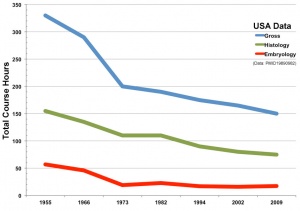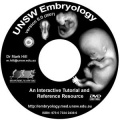Talk:ANZACA Meeting 2012 - Embryology
Page Accesses
- This page was last modified on 7 October 2014, at 18:40. Fixed collapsible Tables. This page has been accessed 3,477 times. --Mark Hill (talk) 21:28, 7 October 2014 (EST)
- This page was last modified on 10 December 2012, at 06:06. This page has been accessed 162 times. --Mark Hill 17:06, 10 December 2012 (EST)
- This page was last modified on 11 December 2012, at 21:54. This page has been accessed 197 times. --Mark Hill 10:47, 13 December 2012 (EST)
- This page was last modified on 13 December 2012, at 10:48. This page has been accessed 986 times. --Mark Hill (talk) 02:02, 23 November 2013 (EST)
Anatomical Sciences Education
Abstracts of the 2012 meeting of the Australian and New Zealand association of clinical anatomists
Volume 26, Issue 5, pages 641–660, July 2013
Article first published online: 3 APR 2013
DOI: 10.1002/ca.22235
- http://onlinelibrary.wiley.com/doi/10.1002/ca.22235/abstract
- http://onlinelibrary.wiley.com/store/10.1002/ca.22235/asset/ca22235.pdf?v=1&t=hobklfqg&s=35d63e31d9b61d808a2a760eab583788bbc922f3
Since 70's
- molecular developmental anatomy.
- assisted reproductive technologies.
- stem cells.
Introduction
The very size and dynamic nature of embryonic development has always made it a difficult topic to teach. The structures are always so small and the changing nature of development means that a feature you identify at any one time is called and becomes something else at a later stage.
Images
Example BGDA_Practical_3_-_Oogenesis_and_Ovulation
File:Human_ovulation_01.jpg
External Links
External Links Notice - The dynamic nature of the internet may mean that some of these listed links may no longer function. If the link no longer works search the web with the link text or name. Links to any external commercial sites are provided for information purposes only and should never be considered an endorsement. UNSW Embryology is provided as an educational resource with no clinical information or commercial affiliation.
- International Association of Medical Science Educators (IAMSE) - Medical Science Educator is the successor of the journal JIAMSE.
2012
Options for postgraduate anatomy education in Australia and New Zealand
N Z Med J. 2012 Mar 30;125(1352):81-8. Campbell IS, Fox CM. Source Division of Surgery, Gold Coast Hospital, Gold Coast, Australia. campbellis@hotmail.com
Abstract
AIMS: Medical education in Australia has changed considerably in recent times. As a result, hours dedicated to subjects such as anatomy have been reduced. Young doctors preparing for a career in anatomy-focussed specialties such as surgery and radiology require an indepth knowledge of this subject matter. Many Australian and New Zealand universities now offer postgraduate anatomy courses to address this potential gap in a budding surgeon's education. This article summarises the current options for postgraduate surgical anatomy education in Australia and New Zealand. METHODS: All universities in Australia and New Zealand were contacted between September 2010 and December 2010 regarding the nature and content of course offerings. An Internet-based search was also conducted. RESULTS: There are currently nine universities in Australia and New Zealand offering postgraduate anatomy courses. Courses vary in contact hours, dissection time, lecture content, and examination methods. There are currently two universities offering a Postgraduate Diploma of Surgical Anatomy - the University of Melbourne, and the University of Otago. University of Western Australia and the University of New England offer a graduate diploma and a graduate certificate, respectively. Several other universities offer courses that deliver quality anatomical education but do not award students a university-recognised qualification. The Australian Orthopaedic Association now offers courses in Perth, Sydney and Brisbane, which delivers anatomy education specific to orthopaedics. CONCLUSIONS: There are a number of courses available to budding surgeons and radiologists to help fill the anatomy education void. With the development of such courses questions of accessibility, affordability and equity remain.
PMID 22472715
2010
Review of anatomy education in Australian and New Zealand medical schools
ANZ J Surg. 2010 Apr;80(4):212-6.
Craig S, Tait N, Boers D, McAndrew D. Source Graduate School of Medicine, The University of Wollongong, New South Wales, Australia. scra9664@med.usyd.edu.au
Abstract
Anatomy instruction at Australian and New Zealand medical schools has been the subject of considerable debate recently. Many commentators have lamented the gradual devaluation of anatomy as core knowledge in medical courses. To date, much of this debate has been speculative or anecdotal and lacking reliable supporting data. To provide a basis for better understanding and more informed discussion, this study analyses how anatomy is currently taught and assessed in Australian and New Zealand medical schools. A mailed questionnaire survey was sent to each of the 19 Australian and 2 New Zealand medical schools, examining the time allocation, content, delivery and assessment of anatomy for the 2008 academic year. Nineteen of the 21 (90.5%) universities invited to participate completed the survey. There was considerable variability in the time allocation, content, delivery and assessment of anatomy in Australasian medical schools. The average total hours of anatomy teaching for all courses was 171 h (SD +/- 116.7, range 56/560). Historical data indicate a major decline in anatomy teaching hours within medical courses in Australia and New Zealand. Our results reveal that as there is no national curriculum for anatomy instruction, the curriculum content, instruction methodology and assessment is highly variable between individual institutions. Such variability in anatomy teaching and assessment raises an important question: is there also variable depth of understanding of anatomy between graduates of different medical courses?
PMID 20575945
2009
Medical education in the anatomical sciences: the winds of change continue to blow

Anat Sci Educ. 2009 Nov-Dec;2(6):253-9.
Drake RL, McBride JM, Lachman N, Pawlina W. Source Cleveland Clinic Lerner College of Medicine of Case Western Reserve University, Cleveland, Ohio 44195, USA. draker@ccf.org
Abstract
At most institutions, education in the anatomical sciences has undergone several changes over the last decade. To identify the changes that have occurred in gross anatomy, microscopic anatomy, neuroscience/neuroanatomy, and embryology courses, directors of these courses were asked to respond to a survey with questions pertaining to total course hours, hours of lecture, and hours of laboratory, whether the course was part of an integrated program or existed as a stand-alone course, and what type of laboratory experience occurred in the course. These data were compared to data obtained from a similar survey in 2002. Comparison between the data sets suggests several key points some of which include: decreased total hours in gross anatomy and neuroscience/neuroanatomy courses, increased use of virtual microscopy in microscopic anatomy courses, and decreased laboratory hours in embryology courses.
PMID 19890982
Integrating case topics in medical school curriculum to enhance multiple skill learning: using fetal alcohol spectrum disorders as an exemplary case
Acad Psychiatry. 2009 Mar-Apr;33(2):143-8.
Paley B, O'Connor MJ, Baillie SJ, Guiton G, Stuber ML. Source Department of Psychiatry and Biobehavioral Sciences, David Geffen School of Medicine at University of California, Los Angeles, CA 90024, USA. bpaley@mednet.ucla.edu
Abstract
OBJECTIVES: This article describes the use of fetal alcohol spectrum disorders (FASDs) as a theme to connect the learning of basic neurosciences with clinical applications across the age span within a systems-based, integrated curricular structure that emphasizes problem-based learning. METHODS: In collaboration with the Centers for Disease Control and Prevention (CDC) and the National Organization on Fetal Alcohol Syndrome, the Western Regional Training Center for Fetal Alcohol Exposure at UCLA developed and integrated educational materials on FASDs into the curriculum for first-year medical students. RESULTS: Quantitative and qualitative evaluations suggested materials were effective in enhancing student knowledge and skills related to FASDs, as well as embryology, brain development, substance abuse, developmental psychopathology, and medical ethics. CONCLUSION: The use of a unifying theme integrating basic science and clinical information and skills is effective for medical student training in the prevention and treatment of common medical problems.
PMID 19398629
2008
Modified use of team-based learning for effective delivery of medical gross anatomy and embryology
Anat Sci Educ. 2008 Jan;1(1):3-9.
Vasan NS, DeFouw DO, Holland BK. Source Department of Cell Biology and Molecular Medicine, New Jersey Medical School, Newark, New Jersey, USA. vasanns@umdnj.edu
Abstract
Team-based learning (TBL) is an instructional strategy that combines independent out-of-class preparation for in-class discussion in small groups. This approach has been successfully adopted by a number of medical educators. This strategy allowed us to eliminate anatomy lectures and incorporate small-group active learning. Although our strategy is a modified use of classical TBL, in the text, we use the standard terminology of TBL for simplicity. We have modified classical TBL to fit our curricular needs and approach. Anatomy lectures were replaced with TBL activities that required pre-class reading of assigned materials, an individual self-assessment quiz, discussion of learning issues derived from the reading assignments, and then the group retaking the same quiz for discussion and deeper learning. Students' performances and their educational experiences in the TBL format were compared with the traditional lecture approach. We offer several in-house unit exams and a final comprehensive subject exam provided by the National Board of Medical Examiners. The students performed better in all exams following the TBL approach compared to traditional lecture-based teaching. Students acknowledged that TBL encouraged them to study regularly, allowed them to actively teach and learn from peers, and this served to improve their own exam performances. We found that a TBL approach in teaching anatomy allowed us to create an active learning environment that helped to improve students' performances. Based on our experience, other preclinical courses are now piloting TBL.
PMID 19177372
2006
The influence of histology and embryology courses on student achievement in gross human anatomy courses
Med Teach. 2006 Jun;28(4):391.
Elizondo-Omaña RE, Guzmán López S, García-Rodríguez Mde L. PMID: 16807188
2005
Team-based learning in a medical gross anatomy and embryology course
Clin Anat. 2005 Jan;18(1):56-63.
Nieder GL, Parmelee DX, Stolfi A, Hudes PD. Source Department of Anatomy and Physiology, Wright State University School of Medicine, Dayton, Ohio 45435, USA. gary.nieder@wright.edu
Abstract
The application of team-based learning (TBL) as a major component of a medical gross anatomy course was evaluated. TBL is a method of small group instruction that addresses some of the shortcomings of other small-group teaching approaches. The core components of TBL were instituted in 12 small group sessions in the course. Each session included objective-oriented assignments, an individual readiness assurance test, a group readiness assurance test and a group application problem. Peer evaluation was carried out on a regular basis. Scores from TBL session activities and course examinations were analyzed and compared to previous years' course performance. Student course evaluation data and faculty feedback were also collected. Student evaluation data and faculty response indicated strong support for the TBL method as it was implemented in the course. Faculty noted improvements in students' day-to-day preparedness and group problem solving skills. Students' mean scores on exams were not significantly different from those of previous years. There was, however, a significantly smaller variance in examination scores that was reflected in a lower course failure rate compared to previous years. Correlation analyses of TBL and examination performance suggested that individual readiness assurance test performance is a good predictor of examination performance. TBL proved to be a superior method for small group learning in our anatomy course. Student performance suggested that TBL may most benefit academically at-risk students who are forced to study more consistently, are provided regular feedback on their preparedness and given the opportunity to develop higher reasoning skills.
PMID 15597377
2002
Embryology in the medical curriculum
Anat Rec. 2002 Apr 15;269(2):89-98.
Carlson BM. Source Institute of Gerontology, University of Michigan, Ann Arbor 48109, USA. brcarl@umich.edu
Abstract
Embryology as a field is in a period of unprecedented change in its knowledge base. Similarly, this is a period of great change in medical curricular planning. One of the most significant questions in embryology education for medical students is how much of the "new" molecular embryology to mix with the "old" developmental anatomy approach. The other question is the most effective venue for instruction in medical embryology. Not all medical curricula have the same objectives; nor do they use the same educational approach. With that in mind, this review outlines several ways in which medical embryology can be offered and how it can be integrated into the medical curriculum. It also lays out topics that are worthy of inclusion in a modern embryology course or sequence. Copyright 2002 Wiley-Liss, Inc.
PMID 12001215
Survey of gross anatomy, microscopic anatomy, neuroscience, and embryology courses in medical school curricula in the United States
Anat Rec. 2002 Apr 15;269(2):118-22.
Drake RL, Lowrie DJ Jr, Prewitt CM. Source Department of Cell Biology, Neurobiology, and Anatomy, University of Cincinanati College of Medicine, Ohio, USA. drakerl@ucmail.uc.edu
Abstract
Directors of courses in the basic anatomical sciences in allopathic and osteopathic medical schools in the United States were surveyed regarding the present composition of their courses. Results indicate the majority of gross anatomy courses are in the range of 126 to 200 total course hours, and that laboratory dissection is a key component of these courses. The majority of microscopic anatomy courses are in the range of 61 to 100 total course hours, generally divided equally between lecture and laboratory components. Additionally, despite the availability of computer technology, microscopes are still used in the vast majority of microscopic anatomy courses. The majority of neuroscience courses are in the range of 71 to 90 total course hours, with most of these hours devoted to lectures. Embryology is usually taught in conjunction with gross anatomy, although some schools present it with the microscopic anatomy course or as a separate course. Most embryology courses are in the range of 6 to 20 total course hours, with only a few having a laboratory component. Copyright 2002 Wiley-Liss, Inc.
PMID 12001219
2000
A clinical anatomy curriculum for the medical student of the 21st century: developmental anatomy
Clin Anat. 2000;13(1):17-35.
[No authors listed]
Abstract
An understanding of human developmental anatomy provides a fundamental framework for the accurate diagnosis and proper treatment of patients with congenital clinical entities, a significant population of any medical practice. Therefore, the regard afforded the study of developmental anatomy in the medical curriculum deserves thoughtful attention. In an effort to provide guidance in designing an undergraduate medical curriculum that properly addresses developmental anatomy, the Educational Affairs Committee of the American Association of Clinical Anatomists (AACA) developed this clinical anatomy curriculum in developmental anatomy. It outlines the subject matter and principles that will not only allow the physician to recognize and treat congenital diseases, but will also provide a solid basis for the incorporation of future discoveries, particularly in the rapidly evolving field of molecular developmental anatomy. The AACA seeks to ensure that all medical students receive thorough training in developmental anatomy and that each student, regardless of the institution attended, will be exposed to a curriculum that will provide the necessary competence and confidence for the effective practice of medicine in the 21st century. Copyright 2000 Wiley-Liss, Inc. Comment in The American Association of Clinical Anatomists' (AACA) Syllabus on the Developmental Anatomy of the 21st Century. [Clin Anat. 2000]
PMID 10617885
Survey of gross anatomy, microscopic anatomy, neuroscience, and embryology courses in medical school curricula in the United States
Anat Rec. 2002 Apr 15;269(2):118-22.
Drake RL, Lowrie DJ Jr, Prewitt CM. Source Department of Cell Biology, Neurobiology, and Anatomy, University of Cincinanati College of Medicine, Ohio, USA. drakerl@ucmail.uc.edu Abstract Directors of courses in the basic anatomical sciences in allopathic and osteopathic medical schools in the United States were surveyed regarding the present composition of their courses. Results indicate the majority of gross anatomy courses are in the range of 126 to 200 total course hours, and that laboratory dissection is a key component of these courses. The majority of microscopic anatomy courses are in the range of 61 to 100 total course hours, generally divided equally between lecture and laboratory components. Additionally, despite the availability of computer technology, microscopes are still used in the vast majority of microscopic anatomy courses. The majority of neuroscience courses are in the range of 71 to 90 total course hours, with most of these hours devoted to lectures. Embryology is usually taught in conjunction with gross anatomy, although some schools present it with the microscopic anatomy course or as a separate course. Most embryology courses are in the range of 6 to 20 total course hours, with only a few having a laboratory component. Copyright 2002 Wiley-Liss, Inc.
PMID 12001219
1992
ATLAS-plus: multimedia instruction in embryology, gross anatomy, and histology
Proc Annu Symp Comput Appl Med Care. 1992:712-6.
Chapman CM, Miller JG, Bush LC, Bruenger JA, Wysor WJ, Meininger ET, Wolf FM, Fischer TV, Beaudoin AR, Burkel WE, et al. Source Learning Resource Center, University of Michigan Medical School, Ann Arbor 48109-0726.
Abstract
ATLAS-plus [Advanced Tools for Learning Anatomical Structure] is a multimedia program used to assist in the teaching of anatomy at the University of Michigan Medical School. ATLAS-plus contains three courses: Histology, Embryology, and Gross Anatomy. In addition to the three courses, a glossary containing terms from the three courses is available. All three courses and the glossary are accessible in the ATLAS-plus environment. The ATLAS-plus environment provides a consistent set of tools and options so that the user can navigate easily and intelligently in and between the various courses and modules in the ATLAS-plus world. The program is a collaboration between anatomy and cell biology faculty, medical students, graphic artists, systems analysts, and instructional designers.
PMID 1482964
http://www.ncbi.nlm.nih.gov/pmc/articles/PMC2248137/pdf/procascamc00003-0687.pdf
10 Most Recent
Note - This sub-heading shows an automated computer PubMed search using the listed sub-heading term. References appear in this list based upon the date of the actual page viewing. Therefore the list of references do not reflect any editorial selection of material based on content or relevance. In comparison, references listed on the content page and discussion page (under the publication year sub-headings) do include editorial selection based upon relevance and availability. (More? Pubmed Most Recent)
Embryology Education
<pubmed limit=10>Embryology+Education</pubmed>
- ↑ <pubmed>19890982</pubmed>











